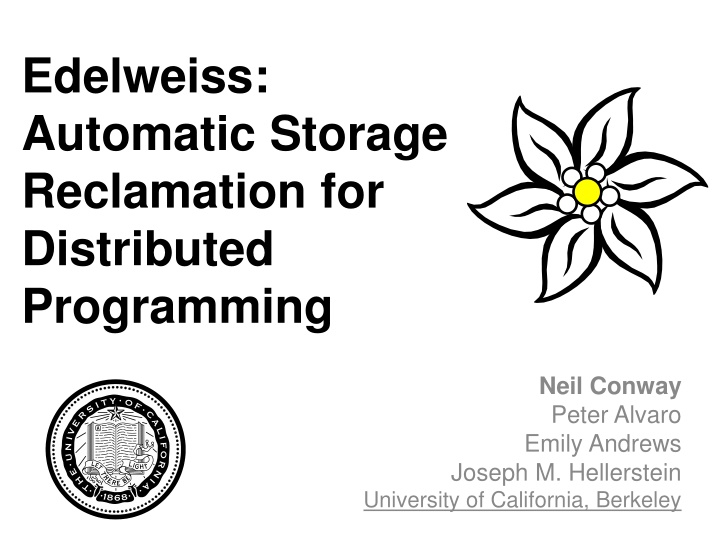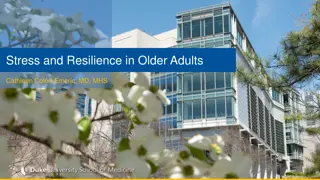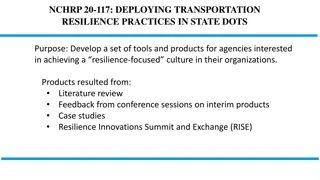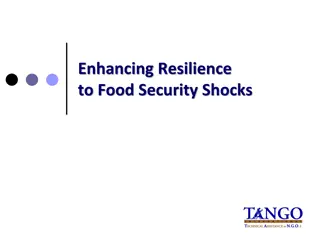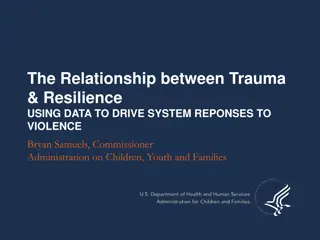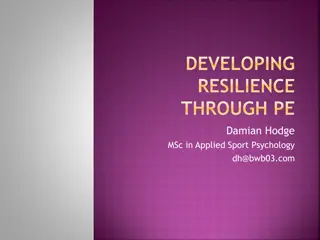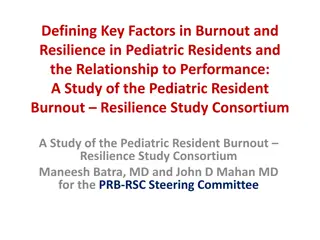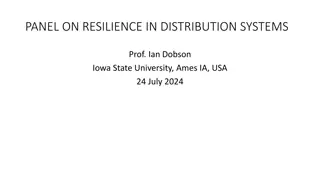Promoting Security and Resilience in Care
All infants, children, and adolescents require a caregiver who provides a secure base, fostering a sense of safety and reducing anxiety. This session explores the Secure Base model, emphasizing the significance of attachment and resilience in fostering positive relationships and building a supportive environment for young individuals in residential care. By focusing on trust, self-esteem, and life story work, this training aims to enhance caregivers' capabilities to promote secure environments and help young people navigate challenges with confidence.
Download Presentation

Please find below an Image/Link to download the presentation.
The content on the website is provided AS IS for your information and personal use only. It may not be sold, licensed, or shared on other websites without obtaining consent from the author.If you encounter any issues during the download, it is possible that the publisher has removed the file from their server.
You are allowed to download the files provided on this website for personal or commercial use, subject to the condition that they are used lawfully. All files are the property of their respective owners.
The content on the website is provided AS IS for your information and personal use only. It may not be sold, licensed, or shared on other websites without obtaining consent from the author.
E N D
Presentation Transcript
Edelweiss: Automatic Storage Reclamation for Distributed Programming Neil Conway Peter Alvaro Emily Andrews Joseph M. Hellerstein University of California, Berkeley
Mutable shared state Frequent source of bugs Hard to scale
Accumulate & exchange sets of immutable events No mutation/deletion Event Logging To delete: add new event Event X should be ignored Current state: query over event log
Example: Key-Value Store Mutable State Event Logging tbl = Hash.new i_log = Set.new d_log = Set.new Insert(k, v): tbl[k] = v Insert(k, v): i_log << [k,v] Update-in-place Delete(k): tbl.delete(k) Set union Delete(k): d_log << k Deletion View(): tbl View(): i_log.notin(d_log, :k) Compute live keys :k =>
Benefits of Event Logging 1. Concurrency 2. Replication 3. Undo/redo 4. Point-in-time query, audit trails (Sometimes: performance!)
Example Applications Multi-version concurrency control (MVCC) Write-ahead logging (WAL) Stream processing Log-structured file systems Also: CRDTs, tombstones, purely functional data structures, accounting ledgers.
Observation: Logs consume unbounded storage Solution: Discard log entries that are no longer useful (garbage collection)
Observation: Logs consume unbounded storage Challenge: Discard log entries that are no longer useful (garbage collection)
Traditional Approach No longer useful defined by application semantics No framework support Every system requires custom GC logic Reinvented many times >25 papers propose ~same scheme!
Engineering Challenges 1. Difficult to implement correctly Too aggressive: destroy live data Too conservative: storage leak 1. Ongoing maintenance burden GC scheme and application code must be updated together
Our Approach 1. New language: Edelweiss Based on Datalog No constructs for deletion or mutation! 2. Automatically generate safe, application- specific distributed GC protocols 3. Present several in-depth case studies Reliable unicast/broadcast, key-value store, causal consistency, atomic registers
Base Data ( Event Logs ) Derived Data ( Live View ) Query
A log entry is useful iff it might contribute to the view. The queries define how log entries contribute to the view. Goal: Find log entries that will never contribute to the view in the future.
Semantics of Base Data Accumulate and broadcast to other nodes Datalog: monotonic Set union: grows over time CALM Theorem [CIDR 11]: event log guaranteed to be eventually consistent
Semantics of Derived Data Grows and shrinks over time e.g., KVS keys added and removed Hence, not monotonic
Common Pattern Live View = set difference between growing sets Insertions that haven t been deleted Key-Value Store Reliable Broadcast Outbound messages that haven t been acknowledged Causal Consistency replaced by a causally later write to the same key Writes that haven t been
Semantics of Set Difference X = Y Z Z grows: Xshrinks If t appears in Z, t will never again appear in X Anti-monotone with respect to Z i_log = Set.new d_log = Set.new Insert(k, v): i_log << [k,v] Delete(k): d_log << k View(): i_log.notin(d_log, :k => :k) Can reclaim from i_log upon match in d_log
Other Analysis Techniques Reclaim from negative notin input Often called tombstones E.g., how to reclaim from d_log in the KVS Reclaim from join input tables Disseminate GC metadata automatically Exploit user knowledge for better GC Punctuations [Tucker & Maier 03]
Whole Program Analysis For each query q, find condition when input t will never contribute to q s output Reclamation condition (RC) For each tuple t, find the conjunction of the RCs for t over all queries When all consumers no longer need t: safe to reclaim
Input program + deletion rules Positive program: no deletion or state mutation Edelweiss Input Program Source To Source Rewriter Datalog Output Program Datalog Evaluator Compute RCs, add deletion rules
Comparison of Program Size 70 Edelweiss 60 Only 19 rules! Bloom Number of Rules 50 40 30 20 10 0 unicast broadcast (fixed) broadcast (epochs) causal broadcast kvs register (write xacts) register (read xacts) request-response causal kvs atomic register
Takeaways No storage management code! Similar to malloc/free vs. GC Programs are concise and declarative Developer: just compute current view Log entries removed automatically Reclamation logic application code always in sync
Conclusions Event logging: powerful design pattern Problem: need for hand-written distributed storage reclamation code Datalog: natural fit for event logging Storage reclamation as a compiler rewrite? Results: Automatic, safe GC synthesis! High-level, declarative programs No storage management code Focus on solving domain problem
Future Work: Checkpoints Closely related to simple event logging Summarize many log entries with a single checkpoint record View = last checkpoint + Query( Logs) General goal: reclaim space by structural transformation, not just discarding data
Future Work: Theory Current analysis is somewhat ad hoc If program does not reclaim storage, two possibilities: 1. Program is not reclaimable in principle (Possible program bug!) 2. Our analysis is not complete (Possible analysis bug!) How to characterize the class of not reclaimable programs?
Reclaiming KVS Deletions Good question X.notin(Y): how to reclaim from Y? 1. Y is a dense ordered set; compress it. 2. Prove that each Y tuple matches exactly one X tuple i_log = Set.new d_log = Set.new Insert(k, v): i_log << [k,v] k is a key of i_log Delete(k): d_log << k View(): i_log.notin(d_log, :k => :k)
